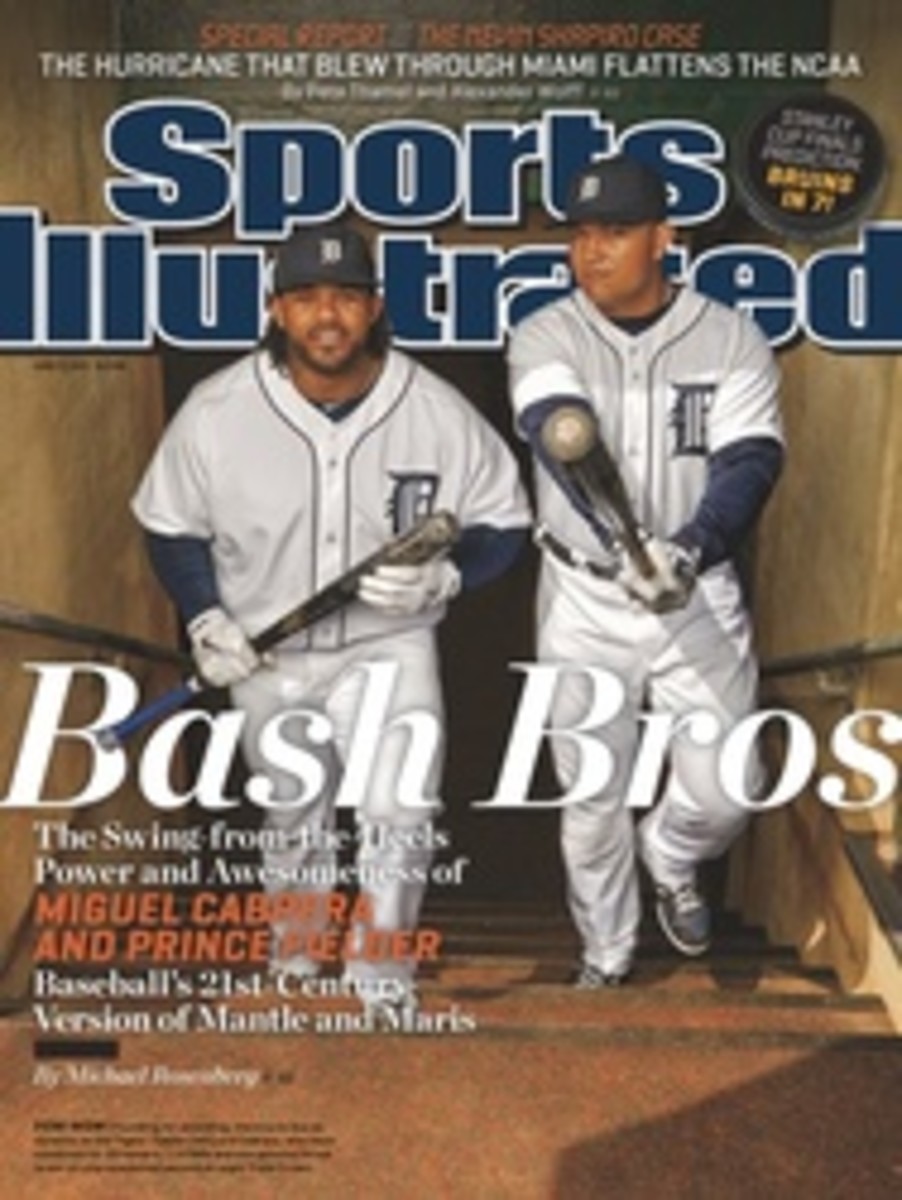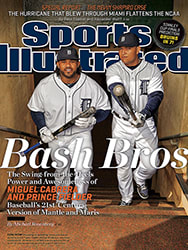
DOCTOR, REVEAL THYSELF
Thirty years after leading the Sixers to the NBA title—Fo'-Fo'-Fo'!—and on the eve of the release of his biopic, Julius Erving paid a house call to share his reflections on several photographs—some rarely seen— from his playing career
MAY 11, 1980 Philadelphia
REVERSE LAYUP, GAME 4 OF THE NBA FINALS VERSUS THE LAKERS
We lost the series. There are plays that are timeless. You see Babe Ruth knock it out of the park, you see Hank Aaron hit 755. Joe Montana throwing the pass into the corner of the end zone. This is one of those moves that won't go away. It's also celebrating the individual; the individual artistry of my game is shown full tilt here, in terms of creating something out of nothing.
When I got in this position, I felt like I had been there before. Actually, the first points I ever scored as a varsity basketball player were on a baseline drive and a layup on the other side of the basket. I was a freshman in high school. I moved up to the jayvee, moved up to the varsity. I played in a varsity game and scored two points. The next day, Newsday had Julius Irving, I-R-V-I-N-G, one field goal, two points. But it was a good two. And it resembled that play right there.
FALL 1982 | Philadelphia
BEFORE THE SIXERS' 1982--83 CHAMPIONSHIP SEASON, THE TEAM'S FIRST WITH MOSES MALONE
[Moses] is a guy who will always be underappreciated. He wasn't always the most articulate guy when he dealt with the media, so they would dismiss a lot of things he said. He's a basketball icon, and he's a great human being. I hope he'll get his due.
I was in China [when I found out the Sixers acquired him]. I was on a mission, and [Celtics guard] M.L. Carr was on the trip. [Sixers] G.M. Pat Williams was on the trip. So we're witnessing to young athletes, kind of on the sly. We'd give them a basketball clinic and then invite them to a Bible study. Bibles were outlawed in China, but we had ours. The previous year we had that great seventh game against Boston, then didn't win the championship against L.A. Thinking about next year, I'm feeling very vulnerable, because M.L. was on the team that won in '81, and he's still bragging about that. "We're gonna get y'all next year, and blah blah blah. You got to the Finals and let L.A. beat you." A chatterbox going on.
Then Pat gets the call that Harold [Katz, the 76ers' owner] made a deal for Moses Malone, and it was like zip. Just zipped M.L. right up. He said, "What, are you s------- me?" I'm like, I got Moses over here. I'm starting to feel good about it. I couldn't wait to get back. For good reason.
MAY 8, 1976 Uniondale, Long Island
BEFORE GAME 4 OF THE ABA FINALS VERSUS THE DENVER NUGGETS
It was springtime. I've got the shoulder bag on the other shoulder—brown bag, shoes are matching, little Cuban [heel] and a linen suit. Yeah, I felt very style conscious at that time. Every time you step out of the house, you're representing your family, representing who you are.
The hair came from a couple of influences. Darnell Hillman, who played for Indiana, always had the biggest 'fro. And Artis Gilmore. It was like, Darnell, Artis and me. We had a little hair competition. Darnell taught me how to make it work, with the cake cutter and the blow-drier. Artis never made his work. It was big but it was all over the place. He always had a lopsided 'fro going. But Darnell, nobody could touch his. He could jump so high, and his hair would just blow in the wind. His hair was a little finer grade, so it moved every time he moved. Mine would hold its position. We kind of took it seriously. I guess it's kind of like what guys do with tattoos now. Everyone gets tatted up, and every time you see them they're adding tattoos. Tattoos are a statement of body art. My body art began and ended right there [points to Afro].
JAN. 27, 1976 | Denver
SLAM FROM THE FREE THROW LINE, ABA DUNK CONTEST
In camps and clinics I would always finish my lecture by running from the foul line and dunking. What can I say? It's a combination of a gift and a lot of hard work and determination and some confidence. The gift is the hang time. In order to get there from the foul line, you've got to get up pretty high. It's a combination of a broad jump and a high jump. I was never great at either one of them, but I was pretty good at putting the combination together.
There's a sensation associated with flying. For me it started as a kid, in the park, jumping out of swings. Right next to my housing projects we had swings, and they were in a huge sandbox. It was white sand. So when you came home dirty, you had sand on you. There was ultimately a fence out there, and I always worried if I went too far I'd hit the fence. I always found a way to land. In the early days, when I was six, seven, eight, it was like a tuck-and-roll. I got to the point where I could jump out of the swing, land and nail it, like in the Olympics, when they do the vault. Height never bothered me. It was early training, and I didn't even know it.
MAY 10, 1974 | Uniondale, Long Island
THE NEW YORK NETS WIN THE ABA CHAMPIONSHIP
That's a bad look right there. Whopper [center Billy Paultz] with his hair slicked back, and [me with] the reversed Nets jersey. Might not even be my jersey. It's just celebrating the moment, feeling no pain. Whopper was a great teammate, a guy who transformed himself from the fat guy at St. John's into the Whopper, somebody you had to deal with. And it took two hands to handle the Whopper. This was one of those moments where you never know when it's going to happen again—or if it's going to happen again.
JAN. 27, 1971 | Amherst, Mass.
JUNIOR YEAR AT UMASS
That's playing Fordham, the great Charlie Yelverton. Their coach was Digger Phelps. I remember in this game we had a point guard who tried to hit me on the break and threw the ball up into the stands. No, actually that was the game at Fordham. This game, this play, I think it was typical. I grabbed a lot of rebounds in college.
My freshman year we were quite an attraction. We'd get the fans in the building early, and then after the freshman game, whether they had to go do homework or not, students used that as an excuse. Halfway through the varsity game they'd be filing out. The next year as a sophomore I never saw anyone filing out at halftime. It was a great experience. It was an innocent time. I took myself seriously as a student. In terms of grant-in-aid, I probably had $50 a month to work with. You talk about stretching a buck. Between that and what my mom would send me, which was maybe another 20, I might have had 70 bucks in my pocket every month for gas and extra stuff other than the dining comm. So I never missed breakfast, lunch or dinner at the dining comm.
MAY 23, 1982 | Boston
GAME 7, CONFERENCE FINALS VERSUS LARRY BIRD'S CELTICS
In '77 [the first season after the merger], Boston played Philadelphia. We had a seven-game series in which we knocked them off. So I was caught up in this rivalry for three years before Bird got there. When people start talking about the Bird-Magic [Johnson] rivalry with Doc, I don't buy it. They're in the first half of their careers, I'm in the last half of my career. I always looked at Kareem [Abdul-Jabbar]. Kareem is the constant for all 11 years I played in the NBA. He is the only one who I ever felt like I was in the shadow of.
SI.COM
For video of Dr. J reminiscing about classic photos, go to SI.com/mag
PHOTO
Photograph by MANNY MILLAN/SPORTS ILLUSTRATED
PHOTO
Photograph by JOHN G. ZIMMERMAN FOR SPORTS ILLUSTRATED
PHOTO
MANNY MILLAN FOR SPORTS ILLUSTRATED
PHOTO
Photograph by CARL IWASAKI FOR SPORTS ILLUSTRATED
PHOTO
WIL BLANCHE FOR SPORTS ILLUSTRATED (UMASS)
PHOTO
TON TOMSIC FOR SPORTS ILLUSTRATED (BIRD)
PHOTO
DAN FARRELL/NY DAILY NEWS/GETTY IMAGES (CHAMPIONSHIP)

